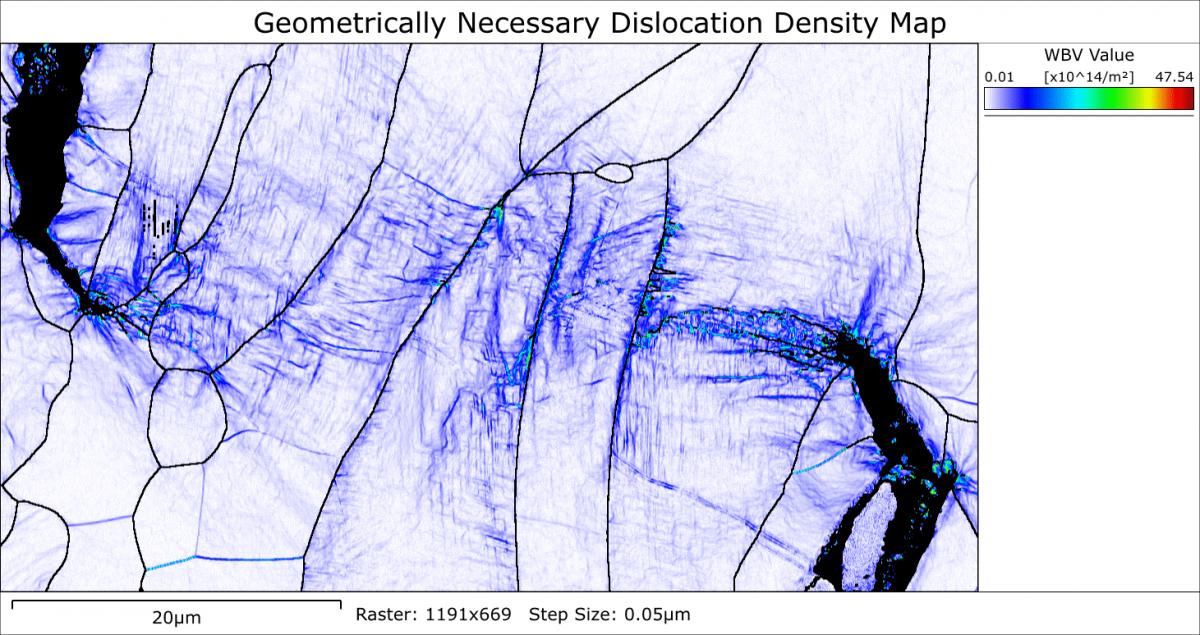技术
Page 4 of 4
You will have learnt in the preceding pages how the microstructure of a material influences many of its key physical properties and how EBSD, often in combination with EDS, is one of the most powerful tools for characterising microstructure. Here we take a brief look at some of the application fields to which EBSD is commonly applied.
The biggest area of EBSD application is in materials science and, more specifically, in the study of metals and alloys. So many of the desired properties of these materials are controlled by the microstructure, so EBSD is an essential tool for their characterisation and for understanding the impact of different processing steps.
For example, the texture in aluminium sheets used for beverage cans is carefully controlled - if it were not the tops of the cans would be uneven, the surfaces not smooth and a lower strength would necessitate thicker (and thus more expensive) sheets.

An EBSD map showing the deformation associated with the propagation of a crack in a steel sample, here illustrated using the geometrically necessary dislocation densities.
Similarly, many electrical and magnetic material properties also depend on crystal orientation. Therefore, the cores of electrical transformers are textured in a way to reduce the energy losses in the transformer.
In the latest generation high strength steels used in the automotive industry, the onus is on developing materials with extreme strength, enabling manufacturers to reduce the overall weight of the vehicle and in turn improving the fuel efficiency. Key here is the fraction of different phases in the steels and EBSD is used to differentiate between austenite, ferrite and even different generations of martensite, as well as providing the necessary grain size and texture information.
Similarly, EBSD is commonly used to understand the mechanisms of failure. Corrosion and subsequent fracture can be initiated at grain boundaries, with some grain boundary types more resistant to these phenomena than others. Material processing routes which encourage the formation of the more resistant boundaries can lead to materials with improved properties – a process known as grain boundary engineering, with the boundary populations characterised by EBSD. An example of this is the improved lifetime of electrodes in batteries that can be processed to have a higher fraction of a particular boundary type.
In the geological sciences, the challenges are slightly different to those in materials sciences: here the end microstructure is studied in order to understand the processes that were active during deformation or metamorphism, potentially many millions of years previously. EBSD is the ideal technique for this, helping to identify slip systems in minerals or accessory phases that may indicate certain temperature and pressure conditions. Increasingly EBSD is also being used as a complement to geochronological studies, aiding the interpretation of radiometric dating results.
Many example applications are provided on the relevant pages throughout the EBSD.com website, but all the time new, exciting applications of the technique are being developed. The table below gives a broad overview of the many fields in which EBSD is routinely being applied.
| Industries | Materials | Typical Measurements |
| Academia | Metals | Grain Size |
| Materials Science | Alloys | Texture |
| Metals processing & Production | Intermetallics | Phase Identification |
| Aerospace | Thin Films | Phase distribution |
| Automotive | Semiconductors | Failure Analysis |
| Government & Defence | Superconductors | Strain Analysis |
| Petrochemical | Ceramics | Deformation & recrystallisation |
| Nuclear | Rocks & minerals | Grain boundaries |
| Chemical | Biomaterials | CSL boundary distribution |
| Microelectronics | Particles | Phase transformation |
| Earth Sciences | Ice | Fracture analysis |
| Energy / Batteries | Nanomaterials | Parent grain analysis |
| Environment | Elastic properties |
 公安机关备案号31010402003473
公安机关备案号31010402003473